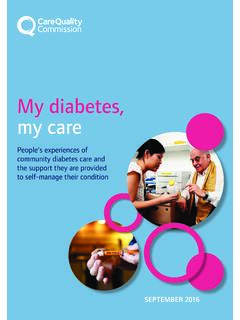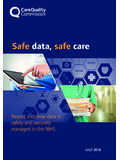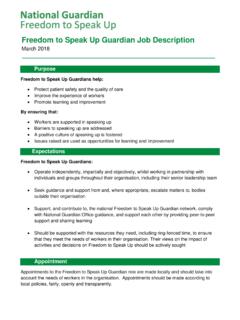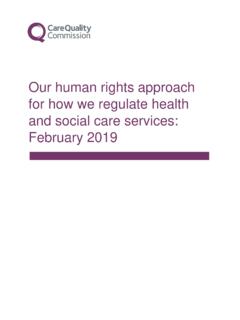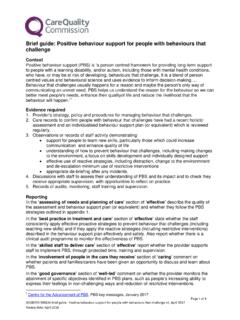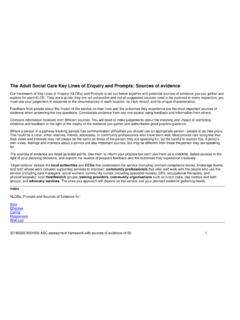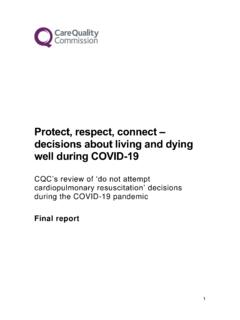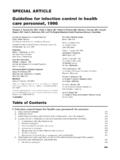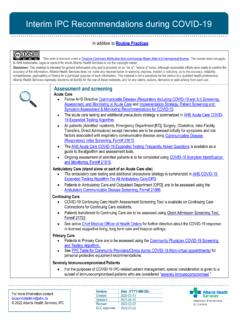Transcription of Infection prevention and control in care homes
1 How care homes managed Infection prevention and control during the coronavirus pandemic 2020. November 2020. Contents 3. 5. Introduction ..10. Purpose of this report ..10. How we carried out this 1. Are all types of visitors prevented from catching and spreading Infection ? ..12. Good Impact on Winter planning ..15. 2. Are shielding and social distancing rules complied with?..17. Good Impact on Challenges for providers and low assurance ..20. 3. Are people admitted into the service safely? ..21. Good Challenges for providers and low assurance ..22. 4. Does the service use PPE effectively to safeguard staff and people using services?..24. Good Impact on Challenges for providers and low assurance ..27. 5. Is there adequate access and take up of testing for staff and people using services?..29. Good Challenges for providers and low assurance ..30. Winter planning ..31. 6. Do the layout of premises, use of space and hygiene practice promote safety?
2 32. Good Impact on Challenges for providers and low assurance ..33. 7. Do staff training, practices and deployment show the service can prevent and/or manage outbreaks? ..34. Good Challenges for providers and low assurance ..36. 8. Is IPC policy up-to-date and implemented effectively to prevent and control Infection ? ..38. Challenges for providers and low assurance ..39. Winter planning ..40. How care homes managed Infection prevention and control during the coronavirus pandemic 2020 2. Foreword The coronavirus pandemic presented care homes with the massive challenge of keeping people safe, while supporting them to live fulfilling lives through person- centred care. Their response varied, as we will see through the analysis of our Infection prevention and control (IPC) inspections that took place throughout August 2020. These inspections showed the level of professionalism and compassion shown by care homes and the wider health and care sector, which we highlight through examples of good practice in this report.
3 IPC is a constant requirement of care homes and is assessed as part of our key question, Is your service safe?'. Care homes have to demonstrate this well year in, year out, despite specific challenges that are not faced by all health and care settings. Care homes are not clinical environments; they are people's homes , and in many cases are converted from older residential properties. This means it can be difficult to adapt the layout to adopt a zoning approach, for example. People have their own bedrooms, with chosen decoration, ornaments, and soft furnishings. This means it is not easy to move people from room to room to facilitate cohorting of those with or without symptoms. This report looks at the eight questions that we seek to assure ourselves about, to make sure that people receive appropriate and personalised care, while being protected through IPC against the spread of COVID-19.
4 Each of these eight questions poses real challenges to care home providers, including how to manage safe admissions; how to shield people while minimising the impact of isolation; how to maximise the benefits of PPE and testing; how to make sure staff training and policies are up-to-date. Most care providers that we have inspected have demonstrated that they have faced these challenges well. They have been supported by staff who have gone the extra mile to keep the people in their care healthy, stimulated, and as independent as possible, while keeping family members and carers informed and engaged. As well as providers' experience of good practice and challenges, we also highlight the impact felt on people using services and their loved ones during the pandemic. The whole of society has struggled to come to terms with the changes needed to stem the spread of Infection . This can be magnified for those who may not be able to fully understand why restrictions are necessary, why their routines and favourite places and pastimes are changed or put on hold, and why they are distanced from their friends and families.
5 Most of this report highlights good practice, but it also includes areas of concern. Where we have seen poor practice through these inspections, we have taken action to ensure providers act quickly to improve the quality of care they are delivering. COVID-19 represents a clear challenge to care homes across the whole of the country. As stated in our State of Care report for this year, and updated in our November COVID-19 Insight report, we have not seen any clear relationship between care home ratings and the number of deaths due to COVID-19 in those homes . The quality of care does not on its own determine whether a care home experienced an outbreak, which is why the learning from IPC is important for all care homes , regardless of their track record. How care homes managed Infection prevention and control during the coronavirus pandemic 2020 3. There is a sector-wide desire to learn from experiences as well as to celebrate and share good practice.
6 This report does not give all the answers, but we are sharing what we know and what people are telling us, to help support care homes to get into as good a position as possible to prepare for the winter and potential future waves of Infection . Kate Terroni Chief Inspector of Adult Social Care How care homes managed Infection prevention and control during the coronavirus pandemic 2020 4. Summary Effective Infection prevention and control (IPC) is essential to protect people from acquiring COVID-19. Providers need to make sure they are taking action to minimise the risk of cross- Infection . During August 2020, we carried out a special programme of IPC inspections in 301. care homes selected as potential examples of where IPC was being done well. We have also reviewed IPC in 139 risked-based' inspections between 1 August and 4. September, which were carried out in response to concerns about safety and quality.
7 During these inspections, we reviewed how well staff and people living in care homes were protected by IPC measures, looking at assurance overall and across eight questions. Across the 440 inspections, we found a high level of assurance in the eight questions (figure 1). At 288 of the 440 services visited (65%), inspectors were assured in all eight of the IPC questions. Effective use of personal protective equipment (PPE) and having up-to-date policies in place were the two areas with the most gaps in assurance. Wherever inspectors encountered poor practice, they escalated this at the time with the manager of the service and signposted to the available guidance. In a few cases an inspector returned to complete a comprehensive inspection or pursued regulatory action. As would be expected, the care homes selected as potential good practice examples generally demonstrated higher levels of assurance across the eight questions than those where we carried out risk-based inspections.
8 How care homes managed Infection prevention and control during the coronavirus pandemic 2020 5. Figure 1: Assurance against IPC themes for care homes inspected between 1 August and 4 September 2020 (440 care homes in sample). Assured Somewhat assured Not assured IPC for visitors 4%18% 78% 97% 2%, 1%. Access to testing 4% 21% 76% 96% 4%. Training to prevent outbreaks 10% 19% 71% 95% 5%, 1%. Safe and hygienic layout 12% 14% 75% 93% 6%, 1%. Safe admission 9% 12% 79% 93% 6%, 1%. Shielding and social distancing 13% 19% 68% 93% 7%, 1%. Effective PPE use 14% 21% 65% 91% 7%, 2%. Up-to-date IPC policy 14% 24% 62% 91% 7%, 2%. Risk-based Good practice Note: Good practice' care homes were those selected for potential good practice; Risk- based' care homes were inspected due to concerns about quality and safety Access to visitors IPC for visitors obtained the highest level of overall assurance (91%), with care homes working hard to comply with visitor guidance.
9 Restrictions have come at a price, however, with many people using services feeling the impact of not seeing their families and carers in the way they are used to. Good services had effective systems in place to ensure visiting could go ahead safely. They took a person-centred approach to individual situations to ensure people's needs were met. Garden visits were well supported and homes looked for methods to keep people in touch with loved ones and the community that did not rely on people meeting face-to-face. Robust systems for screening and PPE for people entering the service were seen to be successful in preventing the spread of Infection . There were some challenges to ensuring social distancing during visits and some signage and screening procedures could have been improved. How care homes managed Infection prevention and control during the coronavirus pandemic 2020 6. There are considerations for all providers going forward on balancing visiting restrictions based on current, local advice, against the rights, health and wellbeing of people who use the service and the risk of harm from isolation.
10 Shielding and social distancing Most services had suitable plans in place to care for people who are symptomatic or COVID-19 positive and protect others living in the care home in the event of an outbreak. Social distancing was promoted and maintained wherever possible. Good services took a person-centred, risk-assessed approach, and took simple practical steps to support people where social distancing was a challenge (for example, when delivering personal care or supporting people living with dementia). To mitigate the impact of isolation, good services provided meaningful activities and ensured people were included in the conversation about their isolation so they better understood it. Good practice included supporting people to access the community safely as lockdown restrictions eased. Where inspectors found gaps in assurance this most commonly related to services that had not considered social distancing in the layout of their services and where staff did not maintain this in their interactions with each other.
